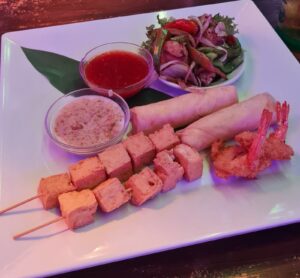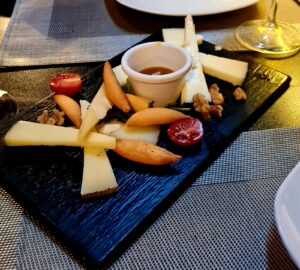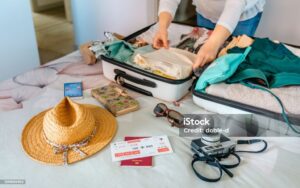Escaping Winter in Gran Canaria: My November Getaway to Maspalomas
When the UK sinks into damp greyness and short daylight hours, Gran Canaria offers a blissful contrast: golden sun, warm sea, and the kind of freedom that lets you breathe deep again. I visited Maspalomas in November 2023—just a short break, but exactly what my soul (and bones) needed. With 25°C days, sunset-stained dunes, and the Atlantic at my feet, I discovered why this island is a perfect winter destination—especially for solo travellers and the LGBTQ+ community.
Gran Canaria in a Nutshell
One of Spain’s Canary Islands, Gran Canaria lies just off the coast of West Africa. It’s known for its diverse microclimates—coastal sunshine, misty mountains, arid deserts, and pine-covered highlands. The island is often described as a “mini continent”, and after just a few days, I understood why.
Currency: Euro (€)
Time zone: GMT (no jet lag from the UK!)
Language: Spanish (though English is widely spoken in tourist areas)
Flight time from UK: Approx. 4.5 hours
Maspalomas: Where the Dunes Meet the Sea
Staying in Maspalomas, I was struck by how surreal it felt—like waking up inside a travel magazine. The Maspalomas Dunes stretch between the town and the ocean, glowing gold at sunrise and casting soft shadows at dusk.
I’ll never forget one morning: I woke up early, took a coffee to-go, and wandered into the dunes just after sunrise. Barefoot in the cool sand, with only the sound of wind and birds—it was one of those rare, grounding travel moments.
The beach here is long and wide, popular with everyone from families to naturists, and yes, lots of gay couples and solo travellers. The southern tip is well known as a gay-friendly zone, particularly the area near Kiosk 7.
Why This Is a Safe Haven for Solo Female Travellers
Travelling alone as a woman can be empowering—but also nerve-wracking. What really struck me in Maspalomas was how comfortable I felt walking alone. In fact, being female in this very LGBTQ+ male-oriented environment was oddly liberating—no one was paying attention to me, in the best possible way!
Still, some safety tips:
Stick to the main paths in the dunes—especially in the early morning or late evening.
Avoid isolated parts at night, even if the vibe feels safe.
Download Google Maps offline, and drop pins to orient yourself—it’s easy to lose direction in the dunes.
My Travel Buddy & The Maspalomas Nightlife
I was travelling with my gay friend, who hit the nightlife hard—clubs at the Yumbo Centrum, drag shows, beach parties—you name it. I, on the other hand, was often asleep before midnight, enjoying the serenity. We joked we were having parallel holidays. Yumbo turns into a celebration of identity, colour, and pride every evening—even outside Pride season.
It’s a brilliant choice if you want vibrant nightlife without feeling pressure to participate. You can enjoy dinner, watch the sunset, then tuck into bed, or party till 4 a.m. It’s your call.
What to See & Do
Maspalomas Dunes
What to do: Sunrise walks, sunset photos, barefoot meditation.
Tip: Wear sunglasses—those golden sands reflect light like snow!
Maspalomas Lighthouse & Promenade
What to do: People-watch, grab a mojito, or shop at nearby boutiques.
My moment: Watching pelicans dive near the shore while sipping papaya juice—simple bliss.
Playa del Inglés
Bustling and loud, this is your zone for budget shops, hearty tapas, nightlife, and LGBTQ+ bars.
Puerto de Mogán
A must-visit for a day trip. Think bougainvillaea-lined canals, artisan markets, and quiet harbours.
Roque Nublo
If you’re up for adventure, hike to this ancient volcanic rock. On clear days, you can even see Mount Teide on Tenerife.
Agaete Valley & the North
Lush greenery, natural pools, and fewer tourists. Ideal if you want something quieter and authentic.
Packing Tips for Winter Sun
Must-haves: SPF 30+, reusable water bottle, sunglasses, light scarf (the wind can surprise you), sandals and trainers.
Layers: Nights can be cooler, especially in inland areas—bring a light jacket or cardigan.
Optional: Waterproof sandals if you plan to explore rocky coves or natural pools.
Budget Breakdown (Based on My Trip)
Flights (return from London): ~£90–£150
Airbnb (4 nights in Maspalomas): £200 total
Daily food & drinks: £25–£35 per day
Transport (bus & occasional taxi): ~£30 total
Total for 4 nights: Approx. £450–£500
Great value, especially when you compare it to 4 grey November days in the UK!
Sustainable Travel Tips
Stay in eco-certified hotels or family-run guesthouses.
Use refillable bottles (tap water is safe but not tasty—bring a filter if needed).
Stick to marked trails in dunes to preserve natural habitats.
Support local businesses: Choose local fruit stands, cafés, and artisans instead of chain stores.
When to Visit
November to March: 20–25°C days, fewer crowds, cheaper prices.
May–October: Hotter weather, peak beach season.
Events: Maspalomas Pride (May & November), Carnival (Feb/March), and various local fiestas.
Other Amazing Places to Visit in Gran Canaria
While Maspalomas is a sun-drenched dream, Gran Canaria is much more than just beaches. Here are some other regions and towns that are definitely worth exploring:
1. Las Palmas de Gran Canaria (Capital City)
Vibe: Urban, cultural, and surprisingly cosmopolitan.
Top sights:
Vegueta, the old town, with cobbled streets and colonial buildings.
Playa de Las Canteras, one of the best city beaches in Europe.
Trendy tapas bars, art galleries, and museums (e.g. Casa de Colón).
Why visit: Great for day trips or an overnight stay—mixes beach life with urban energy.
2. Tejeda
Vibe: Peaceful mountain village surrounded by volcanic peaks.
Highlights:
Breathtaking views of Roque Nublo and Roque Bentayga.
Cozy cafés and artisan bakeries.
Why visit: Ideal for hiking, photography, or just cooling off in summer heat.
3. Agaete & Puerto de las Nieves (Northwest Coast)
Vibe: Authentic, less touristy, with dramatic coastlines and greenery.
Things to do:
Visit Agaete Valley for wine tasting or coffee plantations.
Swim in the natural volcanic pools by the ocean.
Why visit: Great contrast to the dry south—lush and laid-back.
4. Artenara
Vibe: Quietest village on the island, with stunning views and caves.
Unique feature: You can sleep in a cave hotel!
Why visit: For solitude, stargazing, or a digital detox.
5. Fataga
Vibe: A hidden gem on the way to the mountains from Maspalomas.
What to expect: A whitewashed village nestled in a palm-filled valley.
Why visit: A peaceful stop on a road trip inland.
6. Barranco de Guayadeque
Vibe: Mystical and ancient.
What’s cool: Cave homes and restaurants carved into the cliffs.
Why visit: A unique cultural experience—you feel like you’ve time-travelled.
7. Teror
Vibe: Colourful and colonial, with a spiritual feel.
Must-see: Basilica de Nuestra Señora del Pino (the island’s patron saint).
Why visit: Local markets, traditional architecture, and real Canarian life.
Would you like me to merge this into the full article for you, or keep it as a separate travel tip feature?
Final Thoughts
If you’re craving sunshine, solitude, or just somewhere different from the usual tourist circuit, Gran Canaria delivers. Whether you’re wandering silently through dunes, hiking in the misty mountains, or people-watching on a promenade, it’s a place that lets you unwind at your own pace.
As a solo female traveller, I felt safe, welcomed, and free. Add to that affordable flights, warm winter sea, and endless blue skies—and it’s easy to see why this trip stuck with me. Gran Canaria, especially Maspalomas, is not just a sunny escape—it’s a whole reset button for your body and mind.
Taste of Gran Canaria – What to Eat on the Island
One of the joys of visiting Gran Canaria is the food—an exciting fusion of Spanish, African, and Latin American influences. Whether you’re eating alone or sharing tapas with new friends, here are some local specialties and tips to try:
1. Papas Arrugadas con Mojo
The island’s most iconic dish—wrinkled salty potatoes served with two kinds of mojo sauce: red (spicy) and green (herby).
Simple but delicious. You’ll find it everywhere—from beach bars to fancy restaurants.
2. Ropa Vieja Canaria
A hearty stew made from shredded beef or chicken, chickpeas, and potatoes.
Different from the Cuban version—this one is pure Canarian comfort food.
3. Gofio
A traditional flour made from roasted grains (often barley or maize). It’s used in soups, desserts, or even as a side dish.
Locals love it; it’s an acquired taste but very healthy.
4. Fresh Seafood
Being an island, Gran Canaria serves up plenty of fish: try cherne (grouper), vieja (parrotfish), or calamares (squid).
Best enjoyed in small coastal towns like Arinaga or Puerto de Mogán.
5. Queso de Flor
A unique Canarian cheese made using artichoke flower as rennet—creamy and tangy.
Often served as a tapa with local jams or honey.
6. Tropical Fruits & Rum
Don’t miss the bananas, mangoes, or papayas.
Try a local rum like Arehucas—there’s even a rum distillery near Arucas you can visit.
Solo Dining Tips
Eating solo is very relaxed and common in Gran Canaria.
Try tapas bars in Las Palmas or coastal towns—you can order small portions and try lots of things.
Look for restaurants called “Guachinches” or local taverns—they often serve authentic homemade dishes.











